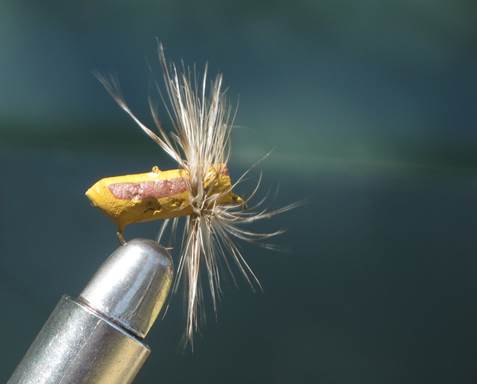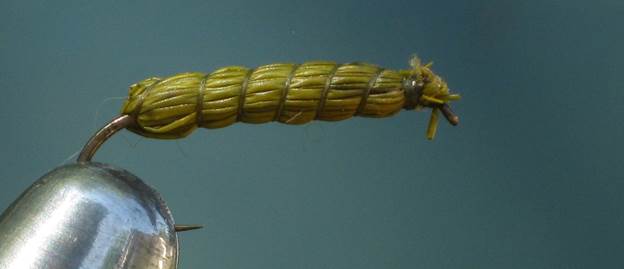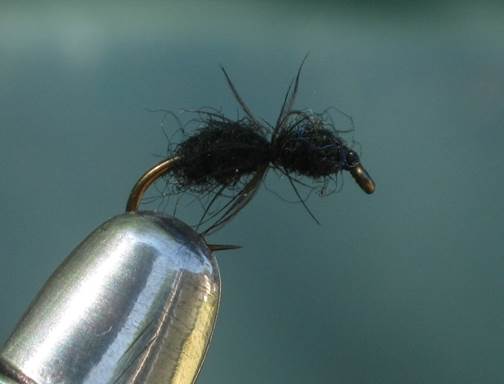HOPPERS AND OTHER CREEPY CRAWLERS
I have always called August the bug month. August represents the final phase of a movement that started several months ago as winter gave way to spring and all of God's creation began to come alive. Under the warm sun of spring the eggs of insects from the previous season begin to hatch and a new generation is born. By the time we arrive at the late summer days of August those newborns are now full grown. Hoppers are hopping, beetles are crawling, ants are swarming; it's a jungle out there.
While there are still some pretty spectacular aquatic insect hatches that the trout angler may experience in late summer, increasingly it's the land based food forms that bring the most action. Anglers find themselves reaching for their box of terrestrial patterns in an attempt to find some activity on their favorite trout water.
Terrestrial fishing is different from fishing to trout feeding on actively hatching insects or masses of mayfly spinners. Most terrestrial fishing involves covering the water searching for a fish that is interested in eating what you are presenting. The successful terrestrial fisher is normally the one that keeps moving, covering the water with a series of casts and then moving on and repeating the process. In my experience it's a rare occasion when there are enough terrestrials on the water to bring on a mass feeding. Terrestrial fishing involves the angler finding the opportunistic feeder and presenting him with an opportunity to feed.
Terrestrial fly patterns are generally quite simple. In fact, I was looking through some of my terrestrial patterns and I discovered a fly that was given to me years ago by a local angler, David Howe. David has been fishing those celestial trout streams for over a decade now, and I cherish this fly that he gave me.

Howe's Hopper
Here we have a basic hopper that is constructed from mostly native materials. The hook is about a size 12, the body is a willow twig that was split and glued on the hook and then was painted yellow. The brown strip on the side represented the legs, and then he cut a groove around the body and made a couple wraps of grizzly hackle. As crude as it appears it does everything that a good dry hopper pattern should do. It lands on the water with a satisfying plop, it floats without the need of any floatant, and it resembles the real thing.
The second fly that I found in my terrestrial box was a Green Worm, or, as we called them back in Michigan, a Greenie Worm.

A Greenie Worm
This fly was tied on a long shank hook and consists entirely of deer hair dyed green. The hair is tied in by the tips and the tying thread is wrapped over the deer hair to the bend of the hook. Then the deer hair is pulled forward completely covering the hook shank and the tying tread is spiral wrapped back to the eye and tied off. I also tied a similar fly by spinning green deer hair over the entire hook shank and clipping it into a round or tapered shape. In Michigan, along the Au Sable River the oak trees that grew along the banks in places were normally infested with these green worms and when they lowered themselves down on their silken lines they often would end up in the water. When they were dropping out of the trees it was often possible to find several good brown trout holding right under the trees and eating the caterpillars as they hit the water. Green caterpillars are quite common and many types of streamside vegetation and this is a good pattern to have in your terrestrial box.

Black Ant
Ant patterns are another popular terrestrial pattern and I carry them in various sizes and colors from all black, black and red, all red, and a straw yellow colored version. Unless I see a specific color and size of ant on the water I generally like to use a big ant, like the one in the image which is a size 12. If I want to increase my odds when fishing terrestrials I will often use a dry imitation, like a hopper and trail a wet ant behind it on a dropper. If you encounter a swarm of flying ants simply use an imitation with wings tied spent or swept over the back.

Hopper
One of the problems that I find that anglers have when fishing terrestrials, especially hoppers, is that, since they are not stream born anglers tend to think that one size fits all. They think that bigger are better and so most of the hopper patterns tend to be on the large size. However, hoppers come in a variety sizes and colors, although I tend to believe that in most cases color is less important than size and presentation. The hopper in the picture is tied on a size 14 standard shank dry fly hook. The body is poly yarn, the wing is brown turkey, and the head is spun deer hair. Early in the summer most of the hoppers in our area are small, and I have even used hoppers as small as size 16. It pays to check the streamside vegetation and see how big the majority of the hoppers are before you select an artificial.
Hoppers need to land on the water with a satisfying plop, and unless the wind is blowing hard enough to drop the hoppers out into the middle of the stream you should be fishing your hopper close to the bank. That is generally true for most terrestrial patterns; however, just like with any type of fly fishing you need to be observant.
Certain types of terrestrials, like ants and termites, swarm in late summer to establish new colonies. Males and females [drones and queens] develop wings and they leave their colonies in tremendous numbers. Through some mechanism that we don't understand all of the ants of a given species tend to swarm at the same time. Ants are not great fliers and when the air is filled with flying ants many of them will end up on the water. This may result in a rise similar to a mayfly or caddis fly hatch. During such an emergence it pays to have an imitation that is close in size and color since the trout can become quite picky.
One day in late September I encountered a pod of large cutthroat trout in a large pool. They were leisurely feeding on the surface, cruising just under the surface and sipping in something that was too small for me to see. I slipped into the water where the water from the pool slipped into a riffle and stuck my aquarium net in the water to see if I could come up with what these fish were eating. It took me several minutes but finally I saw something stuck in the surface film and I scooped it up. It was the smallest ant that I had ever seen; a tiny yellowish ant with wings. The natural was considerably smaller than a size 28 hook. Needless to say those big old cutthroats continued to feed without any interruption from me.
Fortunately, most terrestrial fishing is not that impossible or very technical. The best flies are simple to tie and easy to fish. This is one time when a bad presentation might just be the ticket to success. Most terrestrial insects do not land on the water very gracefully and a fly that hits the water with a distinct splat is an advantage. There is nothing quite like the thrill of splatting down a hopper and watching a big trout come busting out from beneath a tussock of grass and inhaling it. It's a great way to spend the last days of summer.
